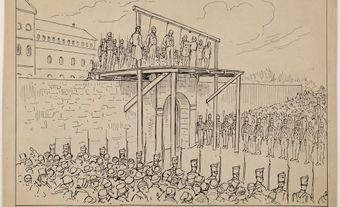Seth (born Gregory Gallant), cartoonist, visual artist (born 16 September 1962 in Clinton, ON). Known for his realistic, elegant graphic novels, where he invents slightly askew histories of Canada and cartooning, Seth is one of the foremost cartoonists in North America.
Early Life
Born to a working class family in small-town Ontario, Seth formed an intense connection with cartooning from an early age. Drawn especially to Charles Schulz's Peanuts, he began a lifelong engagement with the then-disreputable medium, interrupted only briefly by his studies at Toronto's Ontario College of Art and Design (now Ontario College of Art and Design University). In 1985, his interest in cartooning renewed thanks to alternative comics artists like Jaime and Gilbert Hernandez, Seth replaced the Hernandez brothers as an artist on the retro-futuristic Mr. X series, published by Toronto-based Vortex Comics. Eager to explore artistic possibilities beyond genre storytelling, however, he left the comic book in 1988.
Palooka-Ville and Graphic Novels
Seth's signature series, Palooka-Ville, debuted in 1991. Though it continues in annual installments, each of which features several distinct stories, Palooka-Ville began as an irregularly published comic book pamphlet showcasing Seth's (seemingly) autobiographical comics. Life-writing in comics was then on the upswing, and Palooka-Ville became one of the handful of titles to define the trend in the 1990s. The artist publishes the series with Montréal's Drawn & Quarterly, who have also released each of his graphic novels, beginning in 1996 with It's a Good Life, If You Don't Weaken.
Selected as one of the 100 best comics of the 20th century by The Comics Journal, It's a Good Life collects the first long serial from Palooka-Ville. It recounts Seth's discovery of old gag cartoons by Kalo, and details the young artist's efforts to find information about this little-known mid-century Canadian cartoonist. Rendered throughout in the muted style of old New Yorker artists, the book encapsulates the themes that have occupied Seth throughout his career. The artist's work deals with memories of childhood and a bygone Canada; the way that past culture and attitudes persist in the present; rural, urban, and suburban landscapes, often wintry and sparsely peopled; and finally, the anonymous, workmanlike, quietly inspiring quality of both cartooning history and Canadian life. Also, in Kalo's status as a fictional character — never revealed in the book itself, which all along presents its story as fact — Seth reveals his tendency to create fanciful pasts for both comics and Canada, and to knit truth together with invention in ways that are difficult to untangle.
Seth's next major narrative, Clyde Fans, remains in progress, though its first “book” was collected in 2004. Here, Seth departs from the semblance of autobiography to tell the story of two elderly brothers looking back over their anguished past in business together. More importantly, Clyde Fans introduces the fictional northern
Visual Art and Design
These models are part of a larger-scale project that has been exhibited internationally, a handcrafted miniature version of Seth's imaginary city. Along with some of Seth's finished drawings, a selection of pint-sized edifices went on display at the Art Gallery of Ontario in 2005, in that institution's first solo show by a cartoonist since 1975. Seth then made the buildings the central component of his Dominion installation, which toured galleries and museums nationally between 2008 and 2010, and which the artist documents in Palookaville 20 (2010). In addition to the efforts at sculpture and architecture on display in Dominion, Seth has also designed his wife Tania van Spyk's Crown Barber Shop, in Guelph, Ontario as well as the trophies and regalia for the Doug Wright Awards, which he co-founded in 2004 to help recognize achievements in Canadian cartooning.
Seth's drive to encourage thoughtful reflection about deserving comics also informs his accomplished book designs, which include the reprinting of Doug Wright's iconic Canadian strip, Nipper, and Charles Schulz's fifty-year run of Peanuts. Seth's holistic approach to design creates books that are beautiful objects, in which every element, from the covers to the endpapers and beyond, contributes to a greater understanding of the work presented in the book. Though his designs often spotlight the history of comics — as in his own critical monograph, Forty Cartoon Books of Interest (2006) — he has also designed a book of his father's memoirs, Bannock, Beans and Black Tea: Memories of a Prince Edward Island Childhood in the Great Depression (2004), as well as books by other authors such as Dorothy Parker and Lemony Snicket. Seth's illustrated edition of Stephen Leacock's Sunshine Sketches of a Little Town (2013) exemplifies his ability to wholly inhabit another artist's world, providing new visual interpretations of this work for contemporary audiences.
In addition to the above accomplishments, Seth won the Harbourfront Festival Prize in 2010, and has been the recipient of each of the major American comics awards (the Eisner, the Harvey, and the Ignatz). Seth's illustrations have appeared in diverse publications, though most prominently on the cover of the The New Yorker, and his sketchbook compositions have been collected in Vernacular Drawings (2001).

 Share on Facebook
Share on Facebook Share on X
Share on X Share by Email
Share by Email Share on Google Classroom
Share on Google Classroom

